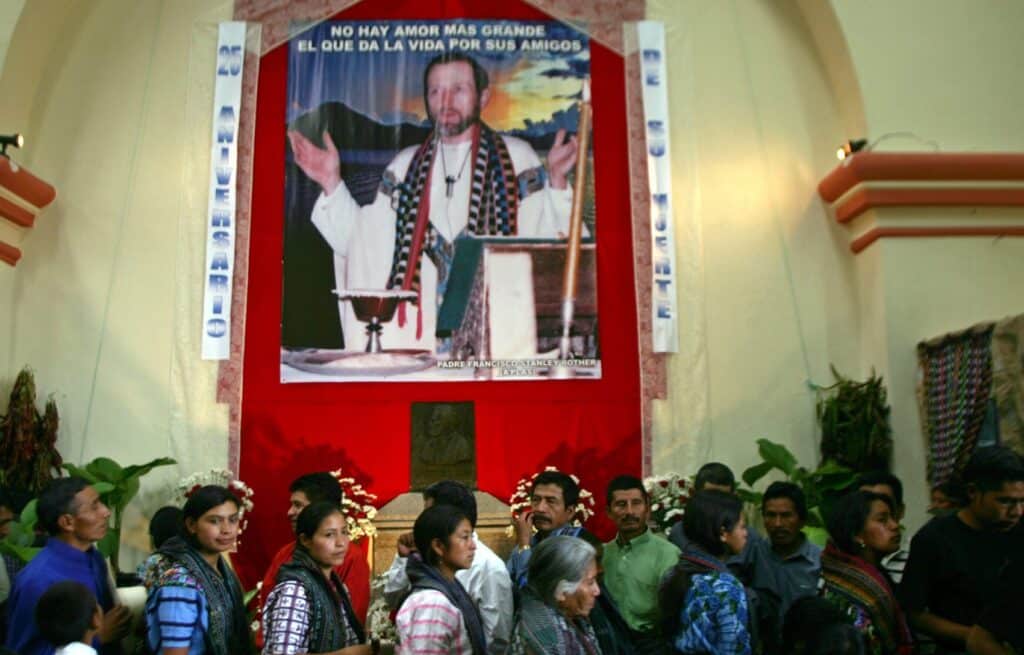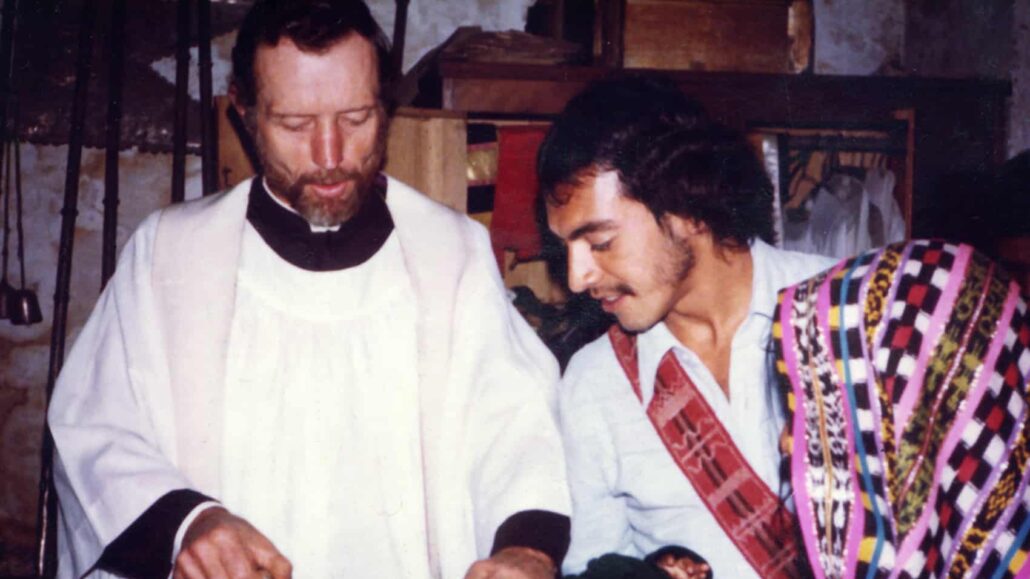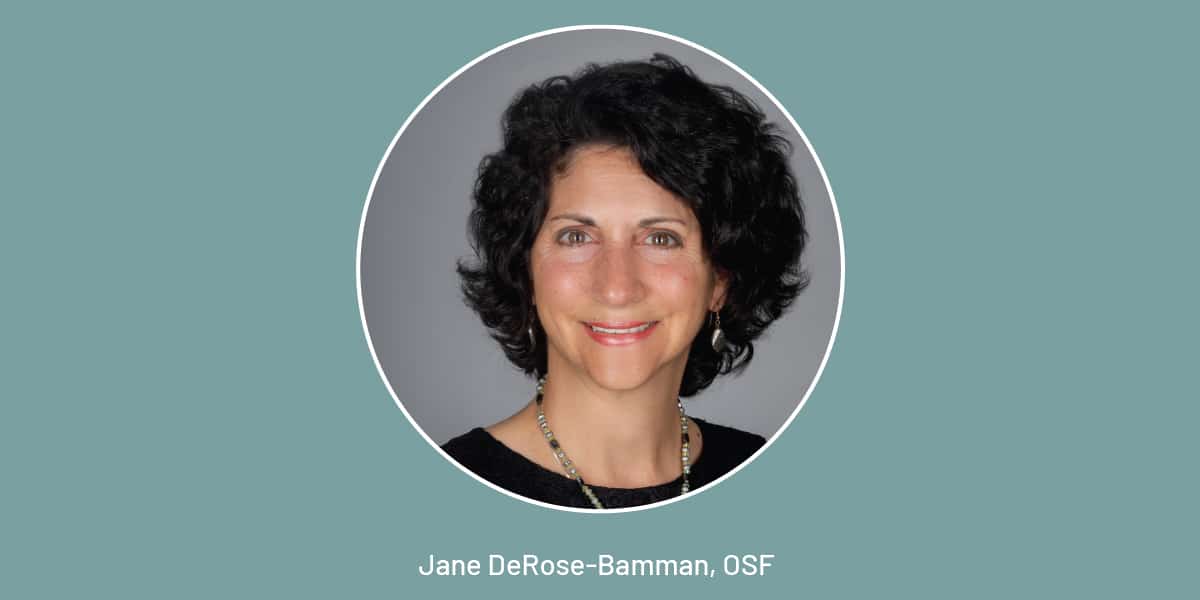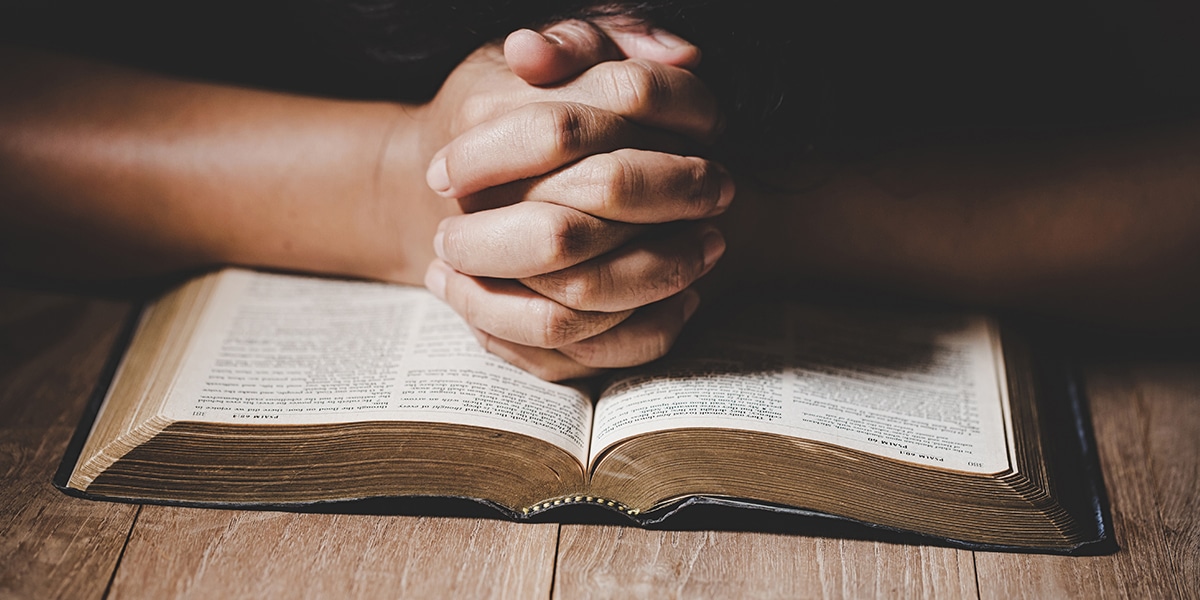Raymond Bailey, a staff member at the United States Embassy, had hastily departed Guatemala City that morning upon learning about the murder of an American missionary, Father Stan Rother. Bailey traveled 50 miles west to Father Stan’s mission in Santiago Atitlán, a village of 20,000 Tzutujil [pronounced ZOO too heel] Mayans on the shores of Lake Atitlán.
The diplomat was not prepared for the throng crowded into the dirt plaza outside the colonial church. Over a thousand dark leathery faces turned toward the whitewashed church with the volcano rising behind it, eyes imploring, beseeching the heavens. Their silence thundered through Bailey. “It was as if they’d lost their God,” he said.
Father Stan Rother so endeared himself to the Tzutujil over 13 years as their parish priest that they still feel his loss today, a quarter century after his murder by a paramilitary death squad. Caught between the revolutionary poor and the military government in Central America’s longest and bloodiest civil war, Stan refused to preach rebellion, but his pastoral devotion to his people eventually cost him his life.
Declared a martyr and since proposed for sainthood by the bishops of Guatemala, Stan was an ordinary man who found extraordinary courage in his faith.
Ordinary Start
Father Stan Rother arrived in Santiago Atitlán in 1968 without fanfare. The then-33-year-old diocesan priest had driven his Chevrolet over 2,000 miles from his native Oklahoma to the Guatemala mission sponsored by the Archdiocese of Oklahoma City. Ordained four years earlier, he had avoided a near miss.
The farm kid from Okarche had flunked out of the seminary on his first try, defeated by the Latin. Only on a second chance from a supportive bishop did he complete his training at Mount St. Mary Seminary in Maryland, where he was more comfortable restoring the school’s grotto than studying in the library.
After several brief pastoral assignments in his home diocese, he accepted an invitation to join five other priests, three religious sisters and three laypeople who staffed the Guatemala mission. Once in Santiago Atitlán, Stan lent a hand to the construction of a hospital and set about the more difficult task of learning Spanish.
By 1975, Stan had become the head missioner by default. The others had left to marry, retire or pursue other assignments. Stan worked hard, true to his German heritage and farm roots, replacing the church’s stained-glass windows, raising the altar, commissioning the renovation of an elaborate altarpiece, overseeing the translation of the New Testament into Tzutujil, experimenting with different crops on the parish farm and fulfilling his pastoral duties. That sometimes meant as many as five Sunday Masses in four different locations and up to 1,000 Baptisms a year. He seemed to blossom with the challenge.
He endeared himself to the people with his unpretentious style. The men who worked the fields respected a priest who was as comfortable atop a tractor as he was at the altar. Families appreciated his visiting their homes—often shacks no more than 15 feet square—and sitting on the floor to break bread with them. The elders honored him with a traditional scarf that he wore proudly on special occasions. Perhaps most significantly, Stan not only learned Spanish, he also learned Tzutujil, a difficult Mayan dialect spoken by the villagers but not by many gringos.
By 1980, Guatemala’s civil war had reached the highlands, including the region of Lake Atitlán. In October, army trucks rumbled into Santiago Atitlán. Troops set up camp on the outskirts of town, occupying a section of the parish farm.
Land of the Disappeared
That week, community leaders started to disappear. The night of October 23, day three of the army’s occupation, soldiers blocked the ends of the street where Gaspar Culan lived. Culan, a former deacon who left the seminary to marry, ran the mission’s radio station, using it as a platform for human rights. Masked men entered his house, shot Culan and dragged him out to a waiting car. His wife and their baby daughter watched the car drive off.
Culan’s kidnapping and presumed murder followed the military government’s counterinsurgency strategy to criminalize and eliminate anyone working to combat poverty, illness and illiteracy. An anti-Communist group later broke into the radio station, rifled files and stole equipment. Rumors raged about informants and names on death lists. Two more community leaders disappeared.
Stan wrote to his archbishop, Charles Salatka, “Anyone who has made an advancement at all is being pursued,” but resolved, “I still don’t want to abandon my flock when the wolves are making random attacks.”
Stan reinforced the church and rectory with fences and locks. He and his assistant, Padre Pedro Bocel, avoided going out at night. Hundreds of villagers sought refuge in the colonial church at night while catechists took turns keeping watch. Stan slept in different rooms of the rectory to confuse possible intruders. The night following the radio station break-in, he slept with his shoes on, afraid that the same group would attack the rectory.
Stan was not a political activist. Nor was he swayed by liberation theology, a movement catching hold in Latin America in the early 1980s. He was aware of the government’s abuses, but his old-school faith swayed him to respond pastorally rather than politically. He set up a fund for the widows and orphans of the disappeared men in his village, knowing the danger of such a charitable deed. “Shaking hands with an Indian has become a political act,” he wrote home.
When one of the mission’s brightest catechists, Diego Quic, wound up on a death list after openly criticizing the army and asked Stan to shelter him in the rectory, the priest knew the danger but couldn’t refuse. His pastoral orientation won out over prudence.
The evening of January 3, 1981, Stan was listening to music in the rectory living room, the way he liked to unwind after a long day. Diego was returning to the rectory, shortly after nightfall. Three masked men ambushed him in front of the church’s stone steps.
Diego fought his way to the rectory porch. The thugs pried him from the wooden banister, splintering the railing. Padre Pedro, the assistant pastor, heard the ruckus and called Stan.
The three masked men wrestled Diego down to a car waiting in the plaza. Stan and Pedro watched the men shove Diego into the backseat. The attackers had Diego’s head covered, but Stan knew it was him. “¡Ayudame! [Help me!],” Diego screamed. One of the kidnappers tried to clamp his hand over Diego’s mouth. “¡Ayudame!”
Stan and Pedro watched in disbelief. The car kicked up dirt out of the plaza. Stan feared they would torture Diego, then murder him in some brutal way, the way he had seen it happen to others. He could do little more than phone the police in the next village, the direction the kidnappers had headed.
The moment shook Stan. Diego’s cry haunted his mind’s ear. “¡Ayudame!”
For days afterward, Stan drove along the roads outside Santiago, looking. He checked fields the killers had littered with other bodies. He visited neighboring village police stations and asked for information about Diego and the kidnappers. He searched the plaza for clues. Nothing. Diego wasdesaparecido [missing].
In a letter to Father John Steichen, chancellor of the Oklahoma City Archdiocese and official liaison to the Santiago mission, Stan described Diego’s abduction in detail. He also described his effort to raise funds to support the eight widows and 32 fatherless children of the 11 men disappeared since the army’s occupation began less than three months earlier.
“Since helping these people,” Stan wrote, “could very easily be considered as subversive by the local government, we have asked that the money be deposited directly in the bank there, and that there be no direct communication between the donors and me….Be careful about sending letters here mentioning relief, etc. We never know when the mail may be intercepted and read. This letter is being hand-carried to the States and I can say things that I ordinarily wouldn’t, using the local mails.”
The New York Times printed this letter after Stan’s death. It had been circulated by human-rights groups and some speculated that it had been seen by the wrong eyes, which may have made Stan a marked man.
Four days after Diego’s kidnapping, in retaliation for a guerrilla attack, the army indiscriminately gunned down 17 civilians near the Chacaya coffee plantation in the Santiago Atitlán area. Stan surveyed the bloody corpses laid out in the plaza under the watchful eyes of his Tzutujil parishioners and the army soldiers. He ordered the bodies of the dead Catholics to be carried to the church for Christian burial—another pastoral duty that could be viewed as public defiance of the military’s terror tactics.
Marked Man of God
On January 12, friends stopped Stan on his way through the neighboring village of San Lucas Toliman, where fellow American missioners Father Greg Schaffer and Father Pat Greene warned Stan, “They’re on the streets to get you.”
Stan refused to leave the country without Padre Pedro, whom the death squads had also fingered. Father Schaffer smuggled Pedro out of Santiago, wrapped in blankets in the back of his car. Stan and Pedro hid for 16 days in Guatemala City until Stan could secure special clearance for the Guatemalan priest to enter the United States.
Stan languished three months at his family’s farm in Okarche, where he grew up. He lent a hand to the spring harvest. He helped his mother clean the house. But his thoughts were in Guatemala. His family would find him sitting in a darkened room, gazing out the window.
He knew the danger, but he could not stomach the thought of abandoning his people. He told a friend about some nuns in Nicaragua who left during the fighting and later wanted to go back. The people asked them, “Where were you when we needed you?”
“I don’t want that to happen to me,” he wrote. “I have too much of my life invested [in Atitlán].”
Another priest invited Stan to preach at his suburban Oklahoma City church in late March. In response to the new Washington administration’s spin on the Communist threat in Central America, Stan commented, “Don’t believe everything your government tells you.” His remarks upset the patriotic sensibilities of at least two parishioners, one of whom wrote the Guatemala Embassy in Washington, D.C., “I feel obliged to warn your nation’s government of the Church involvement within the leftist organizations attempting to establish a socialist (or Marxist) government in Guatemala.”
In April, word arrived that Stan’s name was no longer on the death list. At the time, he did not know that his source for this information was no longer reliable. The archbishop counseled Stan that he might not come back to Oklahoma alive, but Stan insisted he must return to his people. He belonged back with them. He told friends that whatever happened to him would be God’s will. He returned in time to celebrate Holy Week with his parish. Padre Pedro remained in hiding.
Stan plunged back into his ministry. In the early morning hours of July 28, three tall men wearing ski masks and civilian clothes sneaked into the rectory and moved directly to Stan’s upstairs bedroom. Not finding him there, they startled Francisco Bocel in the room across the hall. They demanded that the assistant pastor’s brother, who had been staying at the rectory, lead them to Stan. Francisco noted that they spoke a Spanish dialect unlike that of the local villagers. He also felt a gun pressed against his head.
He led them to the downstairs study that Stan had converted into his bedroom. Padre, they’ve come for you,” he shouted, before slipping away.
Stan had told friends that he did not want to be tortured like those whose bodies he had found with eyes gouged, skin peeled off their face, cigarette burns over their flesh. Francisco heard thuds and furniture tumble. The fight rubbed Stan’s knuckles raw. Francisco heard him yell, “Kill me here!”
The killers pinned Stan into a corner. One fired a shot into his face. Stan crumpled to the floor. The assassin bent over him, placed a handgun against his left temple and fired another shot.
Francisco heard the shots from where he hid in his bedroom. He heard rummaging in the rectory office for several minutes, then quiet. He finally worked up the nerve to wake the Carmelite sisters in the adjoining convent and an American nurse staying in the rectory. They found Stan lying in a pool of his blood. The nurse pronounced him dead. The nuns knelt to pray.
Parishioners without a Padre
Word of the priest’s murder raged through the village and summoned the Atitecos [residents of Santiago Atitlán] to the town’s heart. They grouped on the church’s stone steps and clustered throughout the plaza. They had already lost over 30 of their brothers, fathers, uncles, sons and neighbors. Now their priest was gone.
The crowd alarmed Father Greg Schaffer, who had driven over from San Lucas early that morning. How much longer until the mourners morphed into a mob that marched out to the barracks to avenge their beloved pastor’s murder? Their blind anger would turn a murder into a massacre. With the help of others, he ushered them into the church, where Sister Ana Maria Gonzalez, one of the Carmelite sisters, comforted the crowd with hymns of resurrection.
Inside the church, Schaffer came upon a Tzutujil woman, shriveled by age and curled up in the corner of a pew. Sobs racked her frail body. Schaffer placed a hand upon her shoulder. “They killed our priest,” she said. “He was our priest. He spoke our language.”
Meanwhile, back inside the rectory, Sister Linda Wanner, an American nun who lived and worked in San Lucas, preserved the slain priest’s blood. Just three days earlier, Sister Linda had spent Saturday afternoon with him in that very room. He had sat in the red plastic chair now splattered with his blood. His generous and patient hospitality had impressed her.

She thought of this while she ladled his blood into a mason jar. She thought of the terror he must have felt fighting his attackers. She thought of the senseless brutality behind the bullets they fired. She saw his life poured out on these tiles. She sensed that his faith, his courage had seeped into the very carpet. On her knees, she reverently scooped Stan’s blood into the jar. “I sensed what the blood of martyrs really means,” she says.
Sister Linda found a bullet slug on the ledge of a bookshelf. It must have struck the floor and jumped there. She brought the inch-long bullet to Schaffer, who turned it over to the U.S. embassy officials. The slug came from a nine-millimeter shell used in a Smith & Wesson. This wasn’t the type of gun that fell into the hands of guerrillas or bandits; it was the type used by the army and government-backed paramilitaries.
The Guatemalan police arrested three men from Santiago Atitlán and charged them with killing Stan during a botched burglary attempt—despite the fact that they did not match Francisco Bocel’s description. The three men were convicted, though later acquitted by an appellate court under pressure from the U.S. State Department.
Archbishop Salatka and U.S. Senator Charles Boren of Oklahoma, among others, called for a thorough investigation, though none occurred. Stan’s killers were never brought to justice.
Where He Found His Treasure, His Heart Remains
Stan’s Tzutujil parishioners believed Stan should stay with them. His parents wanted to bury their son in the family’s Okarche plot. They struck a compromise: The Tzutujil enshrined Stan’s heart in the church along with the mason jar of his blood, and Stan’s body returned to Oklahoma. In death, as in life, Stan was of Oklahoma, but his heart resided in the Mayan church.
His memory burns strong in the hearts of those who knew him. “I think he’s a saint,” Father Schaffer says, voicing the thoughts of many, “because of his complete and total dedication and care and giving to those people. That was built on his faith and love of God. He is a good example of what a martyr is about.”










1 thought on “Father Stan Rother: American Martyr in Guatemala”
Deeply moving. I have tears in my eyes with deep gratitude to Our Lord Jesus who raises up Shepherds after his own heart
Comments are closed.